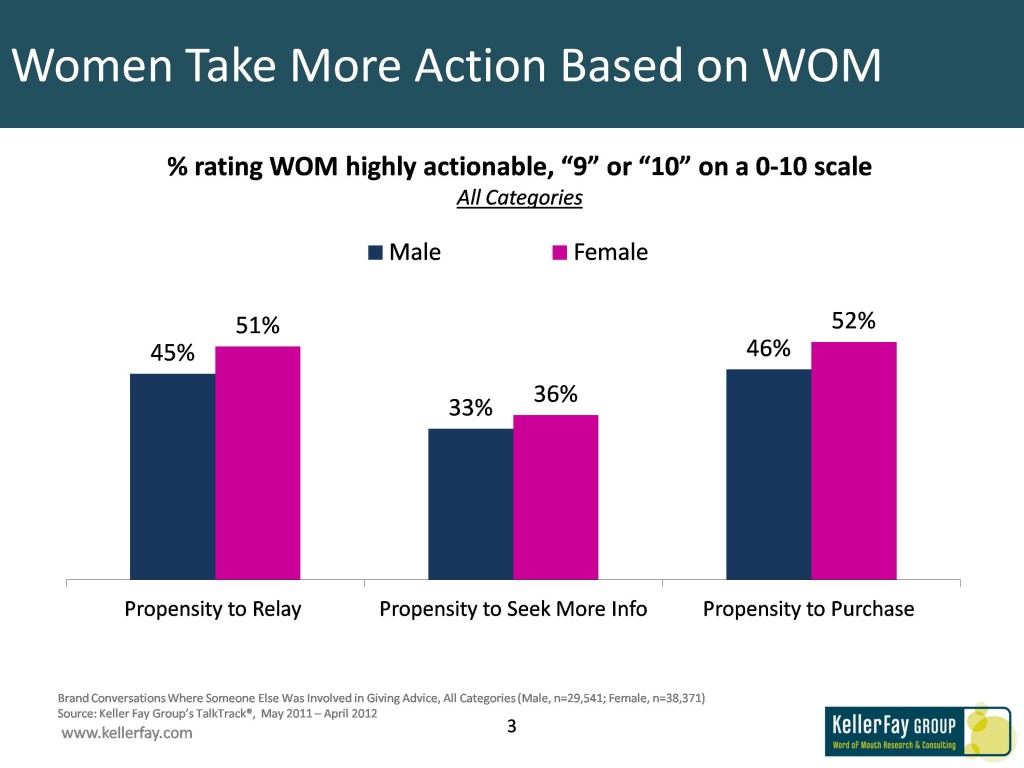Originally featured in Huffington Post
There has been a lot of talk in the media about women dominating social networks and conversations in general. There are infographics like Chicks Rule that clearly show the dominance of women on social networks. And offline we know that the buying power of women is growing.
I decided to see for myself and asked Keller Fay Group, Kred and BlitzMetrics for help with the data crunching. Here is what we found…
Need advice? Ask a Woman
While most marketers know that word of mouth is a powerful force in the marketplace, they would be well advised to know that women’s consumer advice is the most powerful, according to Ed Keller and Brad Fay, the authors of The Face-to-Face Book, newly published by Free Press.
The Keller Fay Group, a market research company focused on measuring word of mouth, has collected data showing that women have 72 conversations each week about brands and companies, versus 64 for men. Keller Fay research also shows that women are more strongly impacted by word of mouth than men. They are more apt to perceive advice from other consumers to be more credible than men do, and they are more likely to purchase based on word of mouth than men, although the results are strong for both genders.

What’s particularly impressive is that men seem to agree that women give better advice than men do. When men receive consumer advice from a woman, 58% of the time they give that advice extremely high marks for credibility. In contrast men give other men those high marks 50% of the time.
These statistics come from a very large research project called TalkTrack®, which uses a survey to monitor the conversations about products and brands that occur among every day consumers. According to the survey, about 90% of these conversations happen offline, including three-quarters that happen face-to-face. The research has involved 700 interviews every week for the last six years, more than 200,000 interviews in total.
“While there’s so much excitement now about Facebook, Twitter, and Pinterest, we think online social media is just the tip of the iceberg when it comes to understanding social media. And often, the iceberg that lies under the surface is very different from what is visible in social media,” said Brad Fay, co-author of the book and co-founder of the research company.
Women are usually more active on social networks
Now let’s look at women’s participation on two social channels: Twitter and Facebook.
To look at Twitter engagement, I asked the data team at Kred, a tool that measures online influence, to run the numbers last week on female vs. male activity on the network globally. Kred examined more than 900M tweets generated in a 72-hour period and identified accounts that were unmistakably female- or male-owned (the rest either belonged to businesses or could not be determined).
The first finding was that women create more content on Twitter; out of the 900M tweets, 19% were posts by women vs. 15% by men. They also have a greater tendency to engage, showing generosity with retweeting others and replying to others. 22% of approximately 170M retweets in the three-day period were from female accounts while 15% were from male-identified accounts. Of the 269M replies, women generated 19% while 16% came from men.
To explore Facebook engagement, I asked Blitzmetrics team to run a query on female vs. male interaction on the network. The results were interesting. They showed that on Facebook women are extremely active, but prefer a lightweight interaction (Likes vs. comments). Out of 1 million posts, with 69% of them in US and 31% international, Blitzmetrics found the following:
- Altogether worldwide 51% of post Likes were generated by women. In US only the number was – 55%, outside of US – 45% (note that Facebook penetration is different in different countries).
- Women also tends to “Like” comments themselves. US: 59% of “Likes on comments” were from women. Outside of US – 45%.
- To be fair men generated more posts and comments than women. The result is consistent within US as well as outside: comments by men comprised 55% vs. 45% by women.
So there you have it, it seems that women mostly do dominate the conversations both online and offline. Not only that, they seem to hold more influence when it comes to advice on purchasing decisions.
